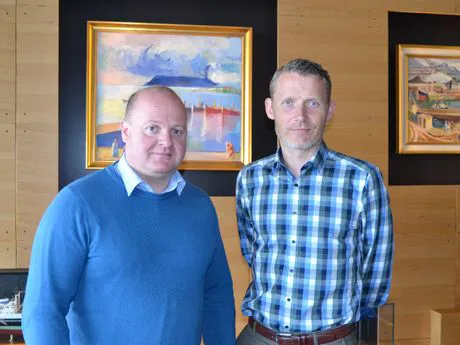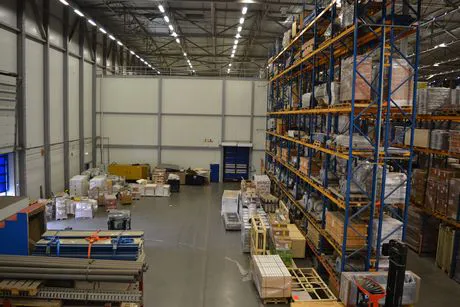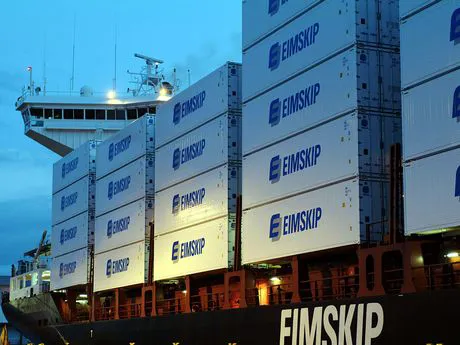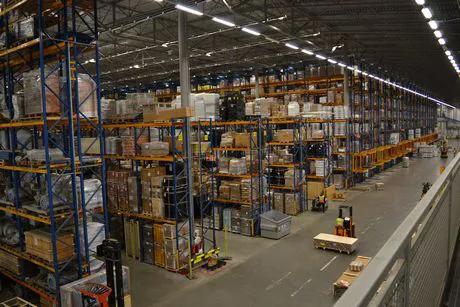
Olafur Bjorn Bjornsson and Brynjar Viggósson.
The Icelandic market relies on shipping and aviation for the supply of products. The island exports mainly fish and aluminium. On the return services, the ships carries, amongst other products, fruits and vegetables to the north. Eimskip is the leading logistics company on the island. The company has a firm foothold in the container market.
Eimskip’s fleet sails mostly in the northern parts of the Atlantic Ocean. The container ships sail on routes connecting North America, North Sea ports and Scandinavia with Iceland. Furthermore there is a partnership with Royal Arctic Line, which sails between Reykjavik and Greenland. The company also serves the Faroe Islands and to ports in northern Norway.

Eimskip ships a lot of different products. The warehouse is filled with all kinds of products. In the back the door to enter the fresh produce department.
After Rotterdam, Denmark is the largest port for the imports to Iceland. "The shipments going via Rotterdam include, for instance, containers coming from southern Europe by truck," explains Brynjar. "We have local partners in Barendrecht which deliver mixed containers." Every Monday and Wednesday a ship from Eimskip sails from the port of Rotterdam. Only on Wednesdays the fruits and vegetables are loaded. If all goes according to plan, the ship arrives on Monday morning, when Brynjar is driving to work, to the quay in Reykjavik. "We import many fruits and vegetables," says Olafur Bjorn Bjornsson, key account manager. "The containers with fruits and vegetables go last on board and are the first to be unloaded."
Fruit and vegetables unloaded first
The place chosen for the containers with fruit and vegetables is important. The products must be transported to importers as quickly as possible. "If the containers with fruit and vegetables are placed below deck, then we fail," states Olafur. However, the weather can cause delays. "The winter months are tough," affirms Brynjar. The fleet is also designed for the rough sea in the north. During the winter months, ships may be delayed by bad weather. According to the manager, importers understand if there are delays. Incidentally, airfreight can also be delayed. For example, planes cannot take off with high winds.

One of the vessels of Eimskip.
"We are strong in a niche," continues Brynjar. He also points out that focusing on the ports up north is a sector in itself. He illustrates this with an example: the pool of charter ships which can be rented when extra capacity is needed is large. You only have this many until the moment when ships must be selected to go north or to specific ports in Iceland. To broaden the possibilities, something that the company has done is to set up an unloading crane in an Icelandic port where there used to be no cranes, but the supply remains limited.

The warehouse where the products are stored.
Smaller vessels necessary
While many large companies are increasingly committed to working with larger ships, Eimskip’s fleet has a maximum capacity of 1.457 TEU. On the ‘yellow route’, which connects amongst others Reykjavik, Immingham and Rotterdam, the maximum capacity is 880 TEU. Larger ships are actually unable to enter some ports that the shipping line works with. Via this yellow routes most fruits and vegetables find its way to Iceland. For example, the port of Vestmannaeyjar, a small island in Iceland, was almost blocked by a lava flow in the volcanic eruption in 1973.
The company started working in the open sea in 1914. Since 1924, the main office is located in the "White House of Reykjavik". Since 2004, the firm can be found at the terminal, close to the centre of the Icelandic capital. While the company initially focused on transport between ports, from the 70’s the focus increasingly switched to door to door transport. To this end, it built cold store facilities in the Icelandic municipality of Hafnarfjordur, named Fjarðarfrost. The company could enlarge that storage from 10.000 up to more than 20.000 tonnes. Eimskip has 57 offices spread across 19 countries, as well as a number of active agents worldwide.
For more information:
Eimskip
Brynjar Viggósson
+354 525 7241
brynjar@eimskip.is
www.eimskip.com
Olafur Bjorn Bjornsson
+354 525 7267
olafur@eimskip.is
www.eimskip.com
